Portal:Peru/Selected picture
Selected pictures
Selected picture 1
Portal:Peru/Selected picture/1
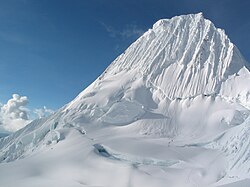
Alpamayo (Spanish: Nevado Alpamayo) is one of the most conspicuous peaks in the Cordillera Blanca mountain range of the Peruvian Andes. It is a steep (sixty degrees), almost perfect pyramid of ice, one of a number of peaks that compose the Santa Cruz massif, the northernmost massif of the Cordillera Blanca. Although smaller than many of its neighboring peaks, it is distinguished by its unusual formation and overwhelming beauty. It actually has two sharp summits, North and South, separated by a narrow corniced ridge. (more...)
Selected picture 2
Portal:Peru/Selected picture/2

Machu Picchu (Quechua: Machu Pikchu "Old Peak") is a pre-Columbian Inca city located at 2,430 m (7,970 ft) altitude on a mountain ridge above the Urubamba Valley in Peru, about 70 km (44 mi) northwest of Cusco. It was built around the year 1450 and abandoned a hundred years later, at the time of the Spanish conquest of Peru. Forgotten for centuries the site was brought to worldwide attention in 1911 by Hiram Bingham. Since then, it has become an important tourist attraction; it was declared a UNESCO World Heritage Site in 1983. (more...)
Selected picture 3
Portal:Peru/Selected picture/3

BAP Carvajal (FM-51) is the first out of four Carvajal-class frigates ordered by the Peruvian Navy in 1973. It was built by the Italian shipbuilder Cantieri Navali Riuniti at its shipyard in Riva Trigoso, Genoa. Its commissioning was delayed until December 23, 1979 due to delays in equipment deliveries by some subcontractors. The Carvajal is named after Vice Admiral Melitón Carvajal (1845–1935) who fought in the War of the Pacific. (more...)
Selected picture 4
Portal:Peru/Selected picture/4

The Palace of Justice (Spanish: Palacio de Justicia) is the seat of the Supreme Court of Peru. It is located in the Lima District of the city of Lima, capital of Peru. Construction started during the second government of Augusto B. Leguía (1919–1930) and finished under the presidency of Óscar R. Benavides, who inaugurated the building in 1938. The Palace was built in a neoclassical style as its plans were based on those of the Law Courts of Brussels, Belgium. However, it lacks the dome of its Belgian counterpart and it is much smaller. (more...)
Selected picture 5
Portal:Peru/Selected picture/5
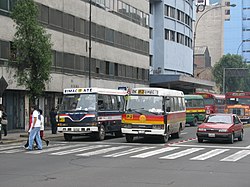
Public transport in Lima is handled by buses, micros, taxicabs, and the so-called mototaxis. Micros are the most common means of public transportation in Lima and many other cities in Peru. The word micro is used in common-day Peruvian Spanish as an abbreviation for microbus (minibus). These privately-owned vehicles are not only known for being very cheap and convenient but also for being rather risky. (more...)
Selected picture 6
Portal:Peru/Selected picture/6
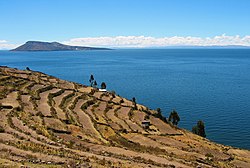
Amantaní is an island on the Peruvian side of Lake Titicaca. According to a 1988 census, it has a population of 3,663 Quechua speakers divided among about 800 families. The island is circular and about 9.28 km² in size. It has two mountain peaks, Pachatata (Father Earth) and Pachamama (Mother Earth), with ancient Inca and Tiwanaku ruins on top of both. The hillsides, are terraced mostly worked by hand and planted with wheat, quinoa, potatoes, and other vegetables. Livestock, including alpacas, also graze the slopes. (more...)
Selected picture 7
Portal:Peru/Selected picture/7

The Huallaga River is a tributary of the Marañón River, part of the Amazon Basin. Old names for this river include Guallaga and Río de los Motilones. The Huallaga is born on the slopes of the Andes in central Peru, and joins the Marañón before the latter reaches the Ucayali River to form the Amazon. (more...)
Selected picture 8
Portal:Peru/Selected picture/8

The city of Ica is the capital of the Ica Region in southern Peru. It was founded in 1563 by Spanish conquistador Gerónimo Luis de Cabrera. According to the 2005 census, it had a population of over 200,000, however, the city suffered extensive damage and loss of life during the 2007 Peru earthquake. (more...)
Selected picture 9
Portal:Peru/Selected picture/9
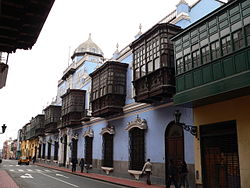
Osambela House (Spanish: Casa de Osambela) is one of the biggest houses built in Lima during the colonial period. This mansion was built between 1803 and 1805, but was officially finished in 1807. It has five balconies and a mirador from which the first owner of the place, Don Martín de Osambela, watched with a spyglass the arrival of galleons to the port of Callao. It was renovated in 2003 and serves as a venue for art exhibitions and cultural events. (more...)
Selected picture 10
Portal:Peru/Selected picture/10

The Peruvian population has been formed by the combination of different groups over five centuries. Amerindians inhabited Peruvian territory for several millennia before Spanish conquest in the 16th century. Spaniards and Africans arrived in large numbers under colonial rule, mixing widely with each other and with Indigenous peoples. After independence, there has been a gradual European immigration. Chinese arrived in the 1850s and have since become a major influence. Other immigrant groups include Arabs and Japanese. (more...)
Selected picture 11
Portal:Peru/Selected picture/11
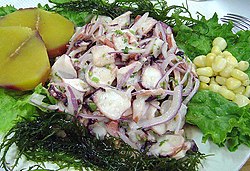
Ceviche is a citrus marinated seafood dish. In addition to adding flavor, the citric acid causes the proteins in the seafood to become denatured, which pickles or "cooks" the fish without heat. The result tastes more like a cooked dish and less like raw fish preparations such as Japanese sashimi. Traditional style ceviche was marinated for up to three hours; modern style ceviche usually has a very short marinating period. (more...)
Selected picture 12
Portal:Peru/Selected picture/12
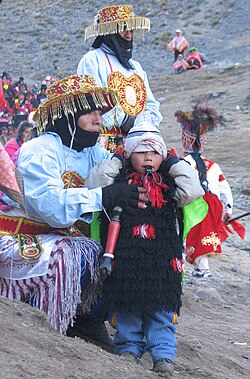
Qolla dancers during the religious festival of Qoyllur Rit'i. Dressed with a knitted mask, a hat, a woven sling and a llama skin, qollas represent the aymara inhabitants of the Altiplano, located to the south of the Qoyllur Rit'i sanctuary. A Ch'unchu dancer can be seen in the background. Wearing feathered headdresses and a wood staff, ch'unchus represent the indigenous inhabitants of the Amazon Rainforest, to the north of the sanctuary. (more...)
Selected picture 13
Portal:Peru/Selected picture/13

The city of Arequipa is the capital of the Arequipa Region in southern Peru. With a population of around 800,000 it is the second most populous city of the country. Arequipa lies in the Andes mountains, at an altitude of 2,380 meters (7740 feet) above sea level, overseen by the snow-capped volcano El Misti. The city has many colonial-era Spanish buildings built of sillar, a pearly white volcanic rock, from which it gets the nickname La Ciudad Blanca ("The White City"). (more...)
Selected picture 14
Portal:Peru/Selected picture/14
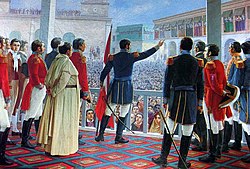
The Independence of Peru was proclaimed in Lima by José de San Martín on July 28, 1821. San Martín occupied the city a few days before after Royalist troops retreated towards the Andes. Despite this proclamation the Peruvian War of Independence lasted three more years as Patriot forces lacked the necessary strength to defeat Viceroy José de la Serna. Eventually San Martín left the country and was replaced by Simón Bolívar, under whose guidance the Royalist army was decisively defeated at the Battle of Ayacucho. (more...)
Selected picture 15
Portal:Peru/Selected picture/15
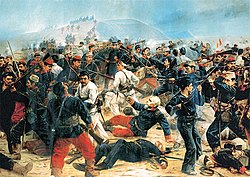
The Battle of Arica took place on June 7, 1880 during the War of the Pacific when Chilean forces led by Colonel Pedro Lagos attacked the port city of Arica, defended by a Peruvian garrison under the command of Colonel Francisco Bolognesi. After heavy fighting the battle ended with a Chilean victory and the death of several Peruvian high-ranking officers including Bolognesi and Alfonso Ugarte. This oil painting by Peruvian artist Juan Lepiani depicts Bolognesi's final moments. (more...)
Selected picture 16
Portal:Peru/Selected picture/16

The Rímac River runs through the Peruvian capital of Lima and is the city's main source of water. One of the oldest bridges spanning the river is the Puente de Piedra (Stone Bridge) built out in stone masonry in the early 17th century. The bridge is still in use and connects the two districts that comprise the Historic Center of Lima: Rímac and Lima Cercado. (more...)
Selected picture 17
Portal:Peru/Selected picture/17
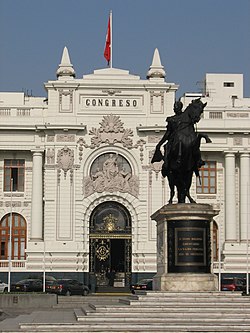
The Peruvian Legislative Palace (Spanish: Palacio Legislativo) houses the unicameral Congress of the Republic of Peru (Congreso de la República) with its 120 Members of Congress (Congresistas). The current building was finished in 1938, during the presidency of Óscar R. Benavides. It is located on Bolívar Square, named in honor of the South American independence leader Simón Bolívar whose statue is in front of the building. (more...)
Selected picture 18
Portal:Peru/Selected picture/18

The main square of Abancay, capital of the Apurímac Region, has several palm trees which have adapted to the city's elevation of 2378 meters above sea level. Most cities in Peru have main squares, which are called Plaza de Armas in Spanish. They are usually surrounded by the principal city buildings such as the town hall or the main church. (more...)
Selected picture 19
Portal:Peru/Selected picture/19
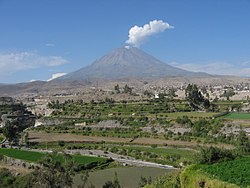
El Misti, also known as Guagua-Putina, is a dormant stratovolcano located in southern Peru near the city of Arequipa. With its seasonally snow-capped, symmetrical cone, El Misti stands at 5,822 m above sea level and lies between the mountain Chachani (6,075 m) and the volcano Pichu-Pichu (5,669 m). Its last eruption was in 1784. Fertile valleys near the foot of El Misti make its surroundings ideal for agriculture. (more...)
Selected picture 20
Portal:Peru/Selected picture/20
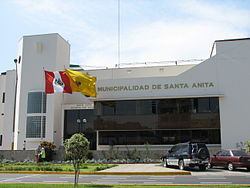
The district of Santa Anita is one of 43 districts in the city of Lima, which are administered by the Metropolitan Lima Municipal Council. Each district has its own council and mayor (Spanish: Municipalidad distrital). The town hall in each district is the seat of the district council. (more...)

The rules
These are selected pictures related to Peru which appear on Portal:Peru. Add new pictures to the next available subpage with a suitable caption and the following syntax:
[[Image:Example.png|centre|250px|short caption]] <center><small>Photo credit: credit</small></center>
Don't forget to update "max=" to new total for the "Selected picture" {{Random portal component}} on the main portal page.
